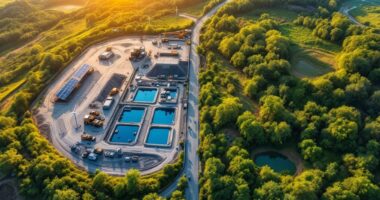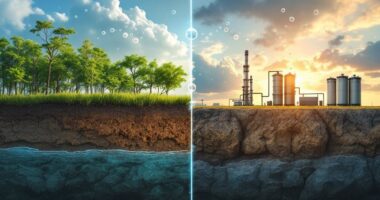Organizations are rapidly transforming their business models to address the climate crisis. Decarbonization strategies include energy efficiency improvements, carbon capture, renewable energy adoption, and digitalization through AI and smart grids. Industries face unique challenges: manufacturing focuses on energy efficiency, financial services prioritize green portfolios, while cement producers seek innovative emissions solutions. Despite upfront costs and regulatory complexities, pioneers like Unilever and IKEA demonstrate that commitment and innovation can successfully chart the course toward a low-carbon economy.

As the climate crisis accelerates, organizations across the globe are developing thorough decarbonization strategies to reduce their carbon footprints and contribute to global sustainability efforts. These companies aren’t just hugging trees – they’re revamping entire business models faster than teenagers swap profile pictures.
The green revolution isn’t just for eco-warriors—it’s reshaping corporate DNA at breakneck speed.
The toolkit for carbon-cutting has expanded dramatically, ranging from the obvious energy efficiency improvements (the low-hanging fruit of the climate action orchard) to the more complex carbon capture technologies (think of them as industrial-sized vacuum cleaners for greenhouse gases).
The journey to carbon neutrality typically begins with a baseline emissions assessment – fundamentally taking a corporate selfie that captures all your carbon blemishes. Organizations then set science-based targets, which are like fitness goals but for planet health instead of beach bodies.
The implementation road involves maneuvering a mix of approaches: shifting to renewables (swapping fossil fuels for sunshine and breeze), electrifying everything that moves, and embracing circular economy practices that turn yesterday’s trash into tomorrow’s treasure. With the energy sector accounting for 75% of emissions, addressing this area represents the most impactful opportunity for meaningful decarbonization. Research shows that Electrification of Uses represents one of the most mature pathways with high CO2 reduction potential.
Different sectors face unique decarbonization challenges. Manufacturing companies are sweating their assets for energy efficiency, while financial services firms are greening their portfolios faster than you can say “ESG criteria.” The transition to renewable sources is increasingly viable as technology costs continue to decrease and efficiency improves.
Even cement production – traditionally as carbon-intensive as a private jet collection – is finding clever ways to reduce emissions through waste heat recovery and digitalization. Meanwhile, retailers are examining their supply chains like detectives on a carbon crime scene.
The tech revolution is turbocharging these efforts. Smart grids are balancing energy like digital DJs, while AI optimizes consumption patterns with uncanny precision. Green hydrogen – the darling of the clean energy prom – promises to transform sectors previously considered decarbonization wallflowers.
Despite promising trends, significant obstacles remain. The upfront costs can make executives clutch their pearls, regulatory landscapes shift like desert sands, and managing emissions across global supply chains is about as straightforward as herding caffeinated cats.
But as corporate pioneers like Unilever and IKEA demonstrate, where there’s climate will, there’s a low-carbon way.
Frequently Asked Questions
How Does Decarbonization Impact Local Job Markets?
Decarbonization creates complex ripple effects in local job markets. While generating millions of clean energy positions overall, it can devastate fossil fuel-dependent communities as facilities close, triggering chain reactions across local economies.
About half of displaced workers have transferable skills, but many require retraining. Communities experience decreased purchasing power, business closures, and population decline.
The shift’s impact varies dramatically by region, with some areas capturing new manufacturing opportunities while others struggle with unemployment and economic contraction.
What Are the Cost Implications for Individual Consumers?
Decarbonization creates a financial seesaw for consumers. Initially, they face higher costs for electric vehicles, energy-efficient appliances, and potentially increased utility bills.
However, long-term savings emerge through reduced energy consumption, lower maintenance expenses, and decreased fuel costs. Government policies like rebates and carbon dividend programs can soften the shift.
Consumers may also benefit from improved health outcomes as pollution decreases, creating indirect financial gains through reduced healthcare expenses.
How Quickly Can Carbon Capture Technologies Be Implemented Globally?
Carbon capture implementation faces a significant time lag.
While projections show capacity growing to 279 Mt CO2/year by 2030 (a sixfold increase), this falls far short of IPCC targets of 1-2 Gt needed for net-zero pathways.
Financial barriers ($665-1,280 billion annually), policy inconsistencies, and social acceptance issues slow deployment.
Government funding and private investment are accelerating adoption, but the current capture rate of 0.1% of global emissions highlights the enormous scale-up challenge ahead.
Which Countries Are Leading in Decarbonization Efforts?
Several countries are spearheading global decarbonization efforts.
The Nordic region shines with Finland’s 2035 net-zero target and Denmark’s ambitious 70% emissions reduction by 2030.
Meanwhile, Uruguay and Iceland have already transformed their electricity sectors to nearly 100% renewables.
Bhutan and Suriname stand out as carbon-negative nations through forest preservation.
The UK has achieved impressive emissions cuts, while China leads in raw renewable energy capacity despite its overall emissions challenges.
Can Nuclear Energy Serve as a Transitional Decarbonization Solution?
Nuclear energy can indeed serve as a transformative decarbonization solution.
With its capacity to generate 10% of global electricity while avoiding 1.5 Gt of emissions annually, nuclear provides reliable 24/7 power that complements intermittent renewables.
Despite challenges of cost overruns and timeline delays, lifetime extensions remain competitive with renewables.
The development of SMRs and advanced reactors could address traditional obstacles, while government support and inclusion in climate finance taxonomies would accelerate deployment.









